Linear Perspective is an important concept in photography and an element of photo composition, it is about how you can capture a three-dimensional scene and present it in a photo with only a two-dimensional plane.
In this article, we are going to explain the meaning of perspective, types of linear perspective, and some tips on how to use linear perspective to get amazing photos.
What Is Perspective in Photography?
Perspective is the spatial relationship between objects within an image. Perspective is a way to make a two-dimensional photograph feel like a three-dimensional scene.
Using perspective techniques can give an impression of depth to your photo and make a scene look more realistic.
In other words, perspective refers to how the eye sees objects relating to one another. It is also used to describe the position and direction from which the image is taken.
Vanishing Point & Horizon line
The vanishing point is a point in the image where parallel lines appear to converge in the distance. Think about standing on a long road. When you look into the distance, it seems like the sides of the road meet at the vanishing point. This optical illusion happens because things look smaller and smaller as they get further away until they seem like a single point.

Photo credit to Depositphotos
A vanishing point is a compositional tool that originates from paintings. It is an excellent way to give depth to a scene. In fact, the vanishing point can add a three-dimensional feel to a two-dimensional photograph or painting.
The horizon line represents the line that divides the sky from the ground, it represents the eye line or “line of sight” of the viewer.
The vanishing point always lies on the horizon line.
What is the Linear Perspective?
Linear perspective is the most common type of perspective photography, and the one most familiar to photographers. Linear perspective occurs when two parallel lines seem to converge as they get farther away from the viewer. Our brain knows that they are parallel and therefore never touch, but they appear to. So, they must be getting farther away.
These converging lines show and emphasize the depth of a frame.
Linear perspective requires two elements: parallel lines and a vanishing point. A vanishing point is typically on the horizon but can be placed anywhere in an image.
Types of linear perspectives
The three linear perspective types are one-point, two-point, and three-point perspectives.
1- One-point perspective
A one-point perspective uses two parallel lines that converge to one vanishing point. This creates depth in the image (think of road, bridge, or train tracks), and the closer those parallel lines come to actually meet, the further away the vanishing point appears.

Photo credit to Depositphotos
The vanishing point and the horizon line are shown below
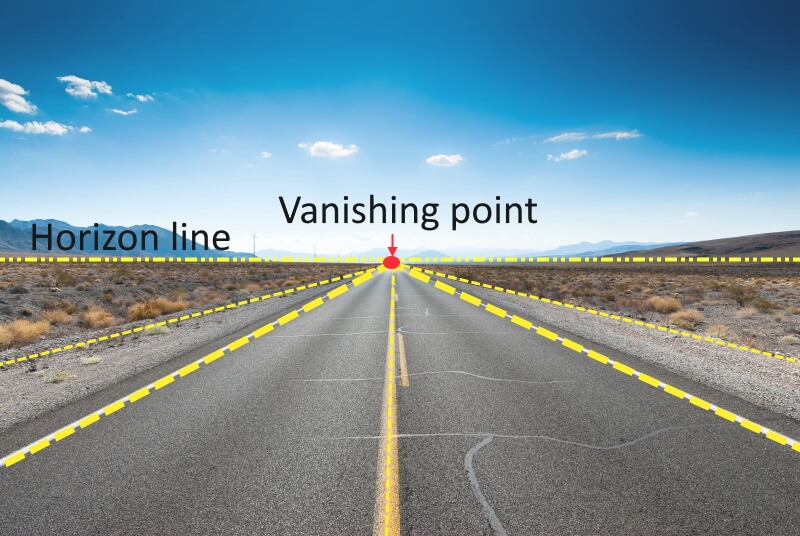
In the following example, the photographer emphasizes the subject in the middle of the frame with strong leading lines drawing the viewer directly to the subject. Also as the building extends into the distance, so it appears smaller, lending depth to the image.

Photo credit to Depositphotos
2- Two-point perspective
Two-point perspective uses two vanishing points that meet and are positioned on the horizon line, like when you take a shoot at the corner of a building.

Photo credit to Depositphotos
The two vanishing points and the horizon line of the above photo are shown below
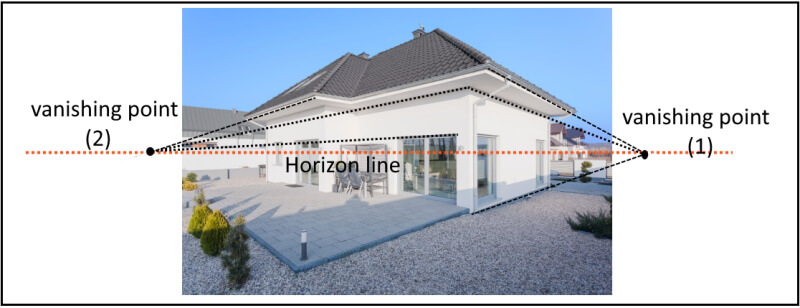
The following photo also has two vanishing points.

Photo credit to Depositphotos
3- Three-point perspective
Three-point perspectives provide the greatest depth and it requires two vanishing points on the horizon line, with the third vanishing point typically being vertically centered, below or above the horizon, creating a top-down or bottom-up perspective, as shown in the below photos.
3-1 Bottom-up

Photo credit to Depositphotos
The three vanishing points and the horizon line of the above photo are shown below. The third vanishing point is located above the horizon line.
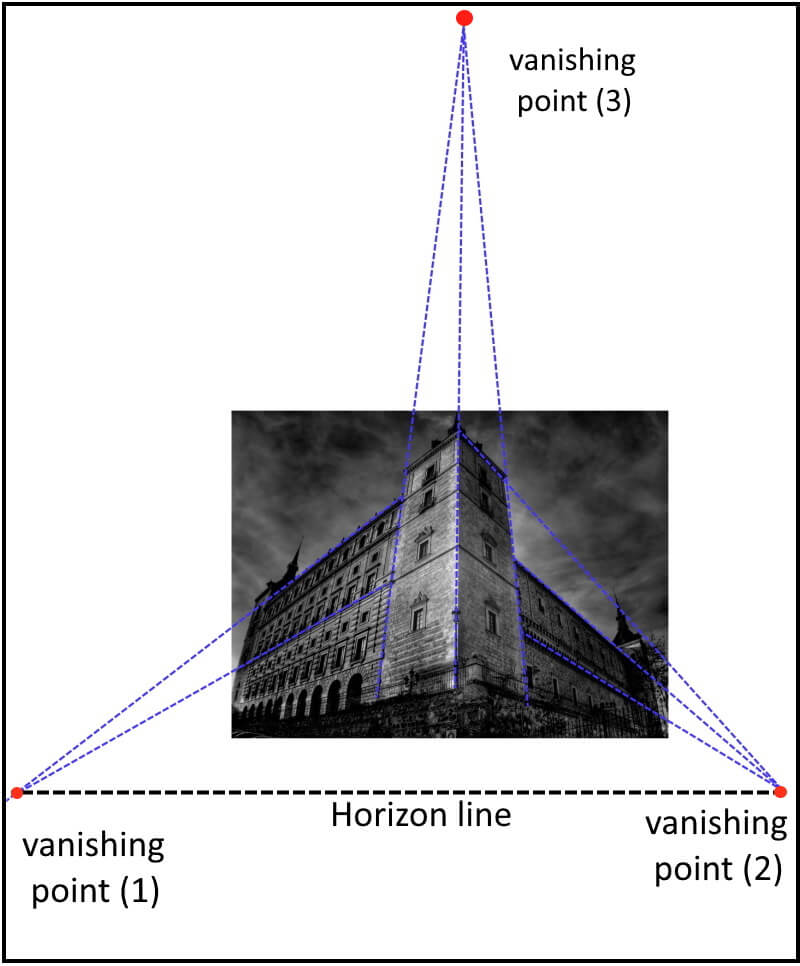
Another example of a photo with three vanishing points.

Photo by Ficky
3-2 Top-down
Looking down at an angle gives us a fresh look and a new perspective. They don’t have to be bird’s eye views. But a point that is higher than our usual level. That is why aerial photography is so popular because these images offer us something new and exciting.

Photo credit to Depositphotos
The three vanishing points and the horizon line of the above photo are shown below. The third vanishing point is located below the horizon line.
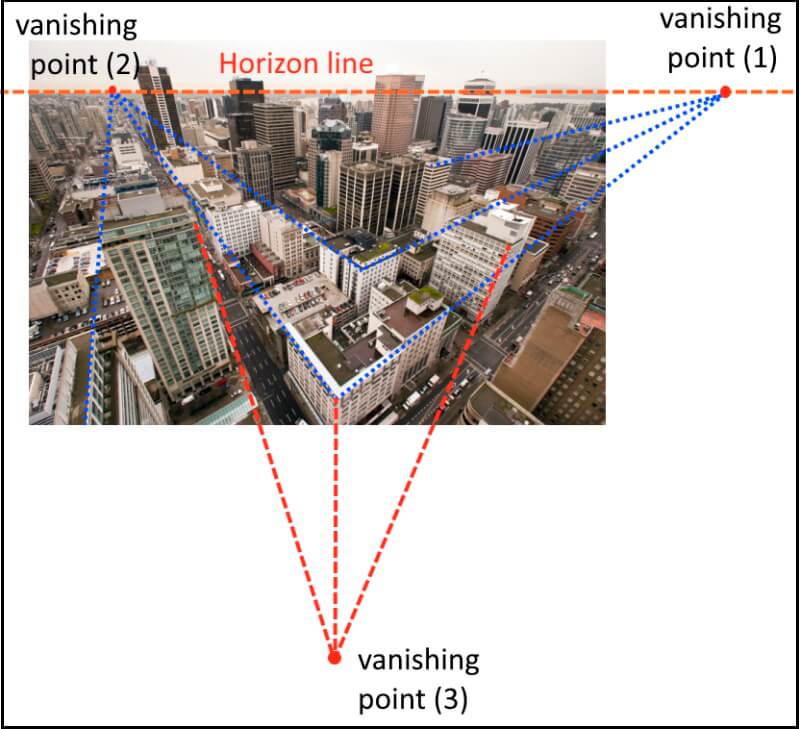
Another example of a photo with three vanishing points.

Photo credit to Depositphotos
How to apply the linear Perspectives
There are things you can do to change the perspective of an image. By moving around your camera, you can gain a better viewpoint than your usual eye level.
Here are some tips and techniques you can use to create a sense of scale and depth in your photos using perspective.
Tip 1: Try different camera levels
Camera position (level) refers to the height of your camera relative to the ground, there are three options here: eye level, high level, and low level. The figure below illustrates these options.

Images by Peter H from Pixabay and Depositphotos
By moving your elevation you can find some interesting and new perspectives. Imagine you are photographing a scene. You decide to get down to the perspective of a low elevation (lower than the eye view level). You will look at the world in a whole different way. We all observe the same scene through the same eyes, day in and day out. But change your vertical position and you have an interesting new perspective.
Tip 2: Try different camera angles
Similar to shooting from different levels, you can also change the angle of your camera to search for unique compositions in the scene. Get down low and point your camera toward the sky. Climb a set of stairs and shoot the scene below you. Once you start experimenting with camera angles and elevation changes, you’ll realize that fresh compositions are everywhere!

Photo credit to Depositphotos
Camera angle refers to its angle relative to the ground, there are the following options:
-
Eye level
The most neutral camera angle is the eye-level shot. The camera points straight ahead at about the same level as the subject’s face.
-
Low angle
Instead of facing straight ahead, the camera looks up at the subject from a low angle.
-
High angle
The reverse of the low-angle shot is the high-angle shot, the camera looks down at the subject from a high angle.
-
Dutch angle
A Dutch angle is achieved by simply tilting the camera to one side so it isn’t level with the horizon.
Tip 3: Use leading lines to add depth to your image
You can use leading lines to direct your viewer’s eye toward the focal point of your photo. Lines can be straight, or curved. The key is that at the end of the “line,” you find something worth emphasizing. Leading lines make use of linear perspective to make your image appear more three-dimensional and interesting.

Photo credit to Depositphotos

Photo credit to Depositphotos
Tip 4: Show a sense of scale
To emphasize the scale sense of your photo, you can add a known element with a defined scale (a person, a chair, etc.) to your scene. Including that person in the scene will also make many images feel more balanced and complete.

Photo credit to Depositphotos
Tip 5: Show a sense of depth
To create more depth in your photo, find an interesting foreground and include it in the whole scene. For example, when you are shooting a sunset over a sea without any objects in the foreground like a rock, or crashing waves, your image will appear flat and two-dimensional.

Photo credit to Depositphotos
Tip 6: Experiment with Different Lenses
Using different types of lenses can help you capture various perspective illusions. For example, a telephoto lens tends to compress the subject and the background closer together. While wide-angle or fisheye lenses make them look farther away.
Fisheye lenses also make all the straight lines outside the lens axis look curved. This can alter your perception of the scene and its representational depth.

Photo credit to Depositphotos
Conclusion
When you are photographing a scene, just think of perspective, and try to find a new position and angle to take the image from. Considering the perspective will help you get a different look at the same subject you are shooting, and it will add variation to your photography.
Related posts
Perspective Photography Ideas – Your Ultimate Guide!
Forced Perspective Photography Ideas
How To Place Anything Into Perspective In Photoshop
Adjust Perspective In Photoshop
Golden Ratio And Photography Composition
10 Rules For Photo Composition
Thanks for reading, I hope you enjoyed the article, in case you have any questions just drop them below & I will be happy to answer you.
The featured photo is credited to depositphotos
If you enjoy the site, don’t forget to subscribe, we will only inform you when a new article is posted.






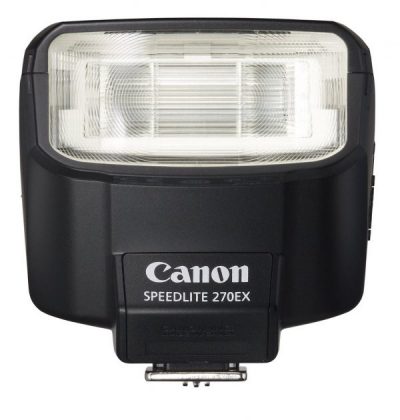
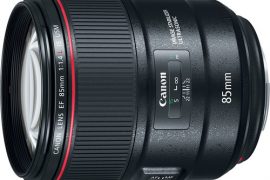

What a great article. Next time I will consider perspective when I am taking pictures of a scene and work to discover a fresh vantage point and angle. So I will enable to capture the same subject in a different light and bring variety to my photographs. This will change a lot in my photographs.
Wow I am not an expert in photography but the linear perspective is very well explained. I really liked the pictures and how you draw the linear perspective from them. I just realized that all the pictures I took during my last vacation in Portugal had all this perspective! Are there other perspectives? Which one is the most interesting?
Thanks for the comment, yes there are couple more types of perspectives: forced perspective and Atmospheric or aerial perspective. Basically, the linear one is more popular.
thanks for your interesting blog post!
A former colleague loved photography and even though she was a practicing nurse, she enrolled in a short course on photography. She said she wanted to be a professional photographer and a nurse at the same time.
I always wondered why she had to take up photography lessons. I thought as long as you have a nice camera and the right subject, you’ll do great. Well, I was wrong and you just explained to me exactly why ☺.
Linear perspective in photography is something that an aspiring photographer must learn and master. And there’s not just one but three linear perspectives. You also answered my question about why photographers position their cameras on different levels and angles and why they use different lenses. Now I know why my colleague did not mind spending on so many lenses.
Thanks for a very informative post.
Thank you for your comprehensive comment. Photography is not just a passion, it needs also learning and practicing a lot.